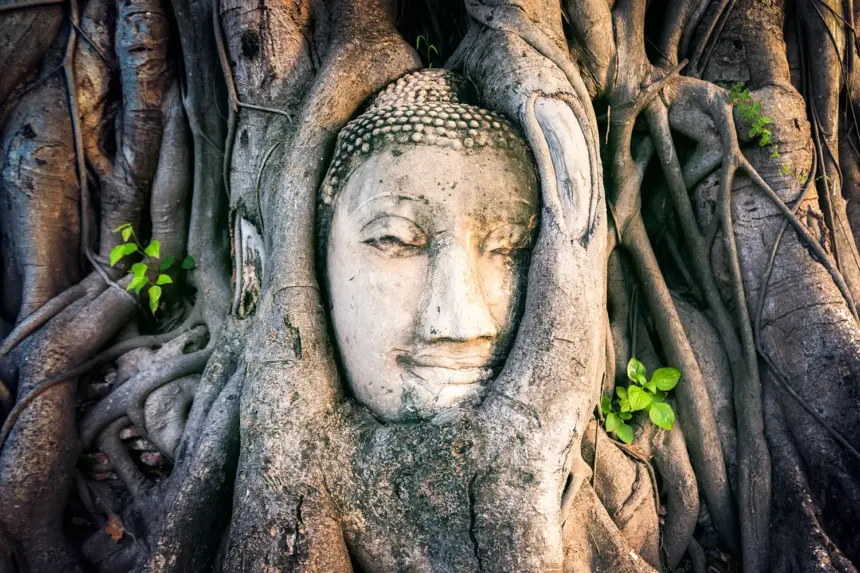The Buddha Head in Tree Roots: A Symbol of Nature and Spiritual Harmony
The image of a Buddha head intertwined with the roots of a banyan tree at Wat Mahathat in Ayutthaya, Thailand, is one of the most iconic and visually striking representations of Thailand’s cultural and religious heritage. Often referred to simply as the “Buddha Head in Tree Roots,” this mysterious and mesmerizing sculpture is a symbol of the fusion of nature and spirituality, attracting visitors from all over the world. Its unique appearance raises questions about its origin, significance, and how it came to be. In this article, we will explore the historical and cultural background of this famous artifact, the story of Wat Mahathat, and the deeper symbolism that the Buddha head and its entwined roots represent.
- The Buddha Head in Tree Roots: A Symbol of Nature and Spiritual Harmony
- Wat Mahathat: The Temple of the Great Relic
- The Origin of the Buddha Head in Tree Roots
- The Symbolism of the Buddha Head in Tree Roots
- 1. Nature’s Embrace of the Buddha:
- 2. The Triumph of Peace Over Destruction:
- 3. The Passage of Time:
- 4. Symbol of Enlightenment:
- A Modern-Day Pilgrimage Site
- Conservation and Preservation
Wat Mahathat: The Temple of the Great Relic
To understand the significance of the Buddha head in tree roots, it is essential to first understand the context of its location, Wat Mahathat. Situated in the ancient city of Ayutthaya, Wat Mahathat, or the “Temple of the Great Relic,” was one of the most important temples in the Siamese kingdom. It served as a major religious and political center from its construction in the 14th century until Ayutthaya’s fall to the Burmese army in 1767.
Wat Mahathat was not only a place for Buddhist worship but also a symbolic representation of the kingdom’s prosperity and power. Its central prang (reliquary tower) once stood majestically, reflecting the architectural influence of the Khmer style. The temple also housed important relics of the Buddha, making it a revered site for pilgrims and royalty alike. However, much of the temple was destroyed during the Burmese invasion, leaving behind only remnants of its former glory, including the famous Buddha head intertwined with the tree roots.
The Origin of the Buddha Head in Tree Roots
The exact origin of how the Buddha head became entangled in the roots of a tree remains a subject of speculation and mystery. Some historians believe that the head originally belonged to one of the many Buddha statues that adorned Wat Mahathat. During the Burmese invasion of Ayutthaya in 1767, the temple, along with much of the city, was looted and destroyed. Many statues were decapitated as a result, and it is likely that the head became separated from the body during this time.
Over the centuries, the banyan tree slowly grew around the head, lifting it from the ground and enveloping it within its roots. The natural growth of the tree and its roots over time created the illusion that the Buddha’s head was deliberately placed within the tree’s grasp. This transformation, from a remnant of war to a peaceful fusion of nature and spirituality, has given the Buddha head a unique status as a symbol of resilience and harmony.
The Symbolism of the Buddha Head in Tree Roots
The image of the Buddha head emerging from the roots of the banyan tree is often interpreted as a powerful symbol of the relationship between nature and spirituality. In Buddhist philosophy, nature is seen as an expression of the interconnectedness of all things, and the image of the Buddha head embraced by the tree roots serves as a visual representation of this belief.
1. Nature’s Embrace of the Buddha:
The banyan tree’s roots seem to cradle the Buddha’s head gently, symbolizing the protective and nurturing power of nature. In Buddhism, nature is often seen as a reflection of the cycle of life, death, and rebirth, and the intertwined roots can be seen as a metaphor for this cycle. Despite the destruction of the temple and the violence that led to the statue’s decapitation, the natural world has not only preserved the Buddha’s image but also transformed it into something even more powerful and sacred.
2. The Triumph of Peace Over Destruction:
The destruction of Ayutthaya by the Burmese was a devastating event, resulting in the loss of countless cultural and religious treasures. However, the survival of the Buddha head, now encased in the roots of the tree, can be seen as a triumph of peace and resilience over violence and destruction. It is a reminder that even in the face of devastation, spiritual values such as compassion, wisdom, and serenity endure.
3. The Passage of Time:
The image of the Buddha head entwined in tree roots is also a powerful reminder of the passage of time and the impermanence of material things. Over centuries, the tree has grown, and the temple has decayed, yet the Buddha’s serene expression remains unchanged. This speaks to the Buddhist teaching of impermanence (anicca)—that all things, including empires, temples, and even statues, are subject to change and decay. However, the spiritual truths represented by the Buddha endure beyond the material world.
4. Symbol of Enlightenment:
The Buddha’s head, in particular, holds significant meaning in Buddhist art and iconography. It represents the enlightened state of the Buddha, characterized by wisdom, compassion, and inner peace. The serene expression on the Buddha’s face, even in its fragmented form, serves as a reminder of the ultimate goal of Buddhist practice—enlightenment (nirvana). The image of the head amidst the roots may symbolize the Buddha’s connection to the natural world, emphasizing that enlightenment is attainable for all beings, regardless of the external conditions.
A Modern-Day Pilgrimage Site
Today, the Buddha head in tree roots at Wat Mahathat has become one of the most photographed and visited sites in Ayutthaya. For many visitors, it is not only a fascinating historical artifact but also a deeply spiritual symbol. The serene expression of the Buddha, juxtaposed with the gnarled and complex network of roots, evokes a sense of peace and contemplation.
Visitors to Wat Mahathat often experience a profound sense of awe and reverence when they see the Buddha head in person. Despite the destruction that occurred in Ayutthaya centuries ago, the Buddha’s calm and peaceful expression endures, providing a moment of reflection for those who come to pay their respects. For Buddhists, it serves as a reminder of the enduring nature of the Buddha’s teachings, while for non-Buddhists, it is a symbol of the harmony between humanity and the natural world.
Conservation and Preservation
The Thai government, along with UNESCO, has taken measures to preserve the ruins of Wat Mahathat and the Buddha head in tree roots. As one of the most recognizable symbols of Ayutthaya, efforts have been made to protect the statue from environmental damage, including the effects of weather and tourism. Visitors are encouraged to be respectful when visiting the site, and photography is allowed, provided it is done from a respectful distance.
Ayutthaya itself has faced challenges in terms of preservation, particularly due to its vulnerability to flooding. The temple ruins, including Wat Mahathat, are periodically affected by seasonal flooding from the Chao Phraya River. Despite these challenges, the site remains a crucial part of Thailand’s cultural heritage and continues to draw visitors from around the world.
Conclusion
The Buddha head in tree roots at Wat Mahathat is a symbol of spiritual resilience, the power of nature, and the passage of time. Its peaceful yet enigmatic presence serves as a reminder of the enduring nature of the Buddha’s teachings and the harmony that can exist between humanity and the natural world.
While the exact origins of how the Buddha’s head became intertwined with the banyan tree may remain a mystery, its symbolic significance is clear. It stands as a testament to the resilience of faith, the beauty of nature, and the eternal quest for enlightenment. Whether you are a devout Buddhist, a history enthusiast, or simply a traveler in search of beauty and meaning, the Buddha head in tree roots is a sight that leaves a lasting impression.










